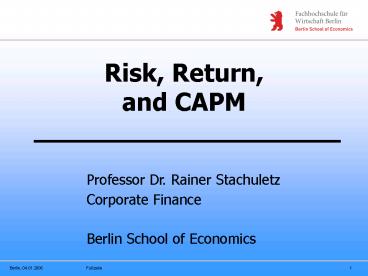Risk, Return, and CAPM - PowerPoint PPT Presentation
1 / 21
Title:
Risk, Return, and CAPM
Description:
Slope of line equals beta, the sensitivity of a stock's returns relative to ... Plots relationship between expected return and betas. Berlin, 04.01.2006. Fu zeile. 18 ... – PowerPoint PPT presentation
Number of Views:41
Avg rating:3.0/5.0
Title: Risk, Return, and CAPM
1
Risk, Return, and CAPM
Professor Dr. Rainer Stachuletz Corporate
Finance Berlin School of Economics
2
Expected Returns
Decisions must be based on expected returns
- Methods used to estimate expected return
Historical approach
Probabilistic approach
Risk-based approach
3
Historical Approach for Estimating Expected
Returns
Assume that distribution of expected returns will
be similar to historical distribution of returns.
Can historical approach be used to estimate the
expected return of an individual stock?
4
Historical Approach for Estimating Expected
Returns
- Assume General Motors long-run average return is
17.0. Treasury bills average return over same
period was 4.1
GM historical risk premium 17.0 - 4.1
12.9 GM expected return Current Tbill rate
GM historical risk premium 2 12.9 14.9
May reflect GMs past more than its future
Limitations of historical approach for individual
stocks
Many stocks have a long history to forecast
expected return
5
Probabilistic Approach for Estimating Expected
Returns
Identify all possible outcomes of returns and
assign a probability to each possible outcome
GM Expected Return 0.20(-30) 0.70(15)
0.10(55) 10
6
Risk-Based Approach for Estimating Expected
Returns
1. Measure the risk of the asset 2. Use the risk
measure to estimate the expected return
1. Measure the risk of the asset
- Systematic risks simultaneously affect many
different assets - Investors can diversify away the unsystematic
risk - Market rewards only the systematic risk only
systematic risk should be related to the expected
return
How can we capture the systematic risk component
of a stocks volatility?
7
Risk-Based Approach for Estimating Expected
Returns
- Collect data on a stocks returns and returns on
a market index - Plot the points on a scatter plot graph
- Yaxis measures stocks return
- X-axis measures markets return
- Plot a line (using linear regression) through the
points
Slope of line equals beta, the sensitivity of a
stocks returns relative to changes in overall
market returns
Beta is a measure of systematic risk for a
particular security.
8
Scatter Plot for Returns on Sharper Image and
SP 500
9
Scatter Plot for Returns ConAgra and SP 500
10
Risk-Based Approach for Estimating Expected
Returns
2. Use the risk measure to estimate the expected
return
- Plot beta against expected return for two assets
- A risk-free asset that pays 4 with certainty,
with zero systematic risk and - An average stock, with beta equal to 1, with an
expected return of 10. - Draw a straight line connecting the two points.
- Investors holding a stock with beta of 0.5 or
1.5, for example, can find the expected return on
the line.
Beta measures systematic risk and links the risk
and expected return of an asset.
11
Risk and Expected Returns
What is the expected return for stock with beta
1.5 ?
12
Portfolio Expected Returns
How does the expected return of a portfolio
relate to the expected returns of the securities
in the portfolio?
The portfolio expected return equals the weighted
average of the portfolio assets expected returns
- Expected return of a portfolio with N securities
E(Rp) w1E(R1) w2E(R2)wnE(Rn)
- w1, w2 , , wn portfolio weights
- E(R1), E(R2), , E(RN) expected returns of
securities
13
Portfolio Expected Returns
E (Rp) w1 E (R1) w2 E (R2)wn E (Rn)
E (Rp) (0.125) (10) (0.25) (12) (0.125)
(8) (0.5) (14) 12.25
14
Portfolio Risk
Portfolio risk is the weighted average of
systematic risk (beta) of the portfolio
constituent securities.
ß P (0.125) (1.00) (0.25) (1.33) (0.125)
(0.67) (0.50) (1.67) 1.38
But portfolio volatility is not the same as the
weighted average of all portfolio security
volatilities
15
Security Market Line
Security market line The line connecting the
risk-free asset and the market portfolio
16
Security Market Line and CAPM
The two-asset portfolio lies on security market
line
Given two points (risk-free asset and market
portfolio asset) on the security market line, the
equation of the line
The equation represents the risk and return
relationship predicted by the Capital Asset
Pricing Model (CAPM)
17
The Security Market Line
Plots relationship between expected return and
betas
- In equilibrium, all assets lie on this line.
- If individual stock or portfolio lies above the
line - Expected return is too high.
- Investors bid up price until expected return
falls. - If individual stock or portfolio lies below SML
- Expected return is too low.
- Investors sell stock driving down price until
expected return rises.
18
The Security Market Line
19
Efficient Markets
Efficient market hypothesis (EMH) in an
efficient market, prices rapidly incorporate all
relevant information
Financial markets much larger, more competitive,
more transparent, more homogeneous than product
markets
Much harder to create value through financial
activities
Changes in asset price respond only to new
information. This implies that asset prices move
almost randomly.
20
Efficient Markets
If asset prices unpredictable, then what is the
use of CAPM?
CAPM gives analyst a model to measure the
systematic risk of any asset.
On average, assets with high systematic risk
should earn higher returns than assets with low
systematic risk.
CAPM offers a way to compare risk and return on
investments alternatives.
21
Risk, Return, and CAPM
- Decisions should be made based on expected
returns. - Expected returns can be estimated using
historical, probabilistic, or risk approaches. - Portfolio expected return/beta equals weighted
average of the expected returns/beta of the
assets in the portfolio. - CAPM predicts that the expected return on a stock
depends on the stocks beta, the risk-free rate
and the market premium.































